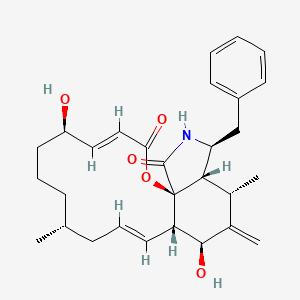| MeSH term | MeSH ID | Detail |
|---|---|---|
| Hemolysis | D006461 | 131 associated lipids |
| Tuberculosis | D014376 | 20 associated lipids |
| Uremia | D014511 | 33 associated lipids |
| Diabetes Mellitus | D003920 | 90 associated lipids |
| Adenocarcinoma | D000230 | 166 associated lipids |
| Dermatitis, Contact | D003877 | 59 associated lipids |
| Lupus Erythematosus, Systemic | D008180 | 43 associated lipids |
| Lung Neoplasms | D008175 | 171 associated lipids |
| Wounds and Injuries | D014947 | 20 associated lipids |
| Adenoma, Islet Cell | D007516 | 7 associated lipids |
CYTOCHALASIN B
CYTOCHALASIN B is a lipid of Polyketides (PK) class. Cytochalasin b is associated with abnormalities such as Renal tubular disorder and Chagas Disease. The involved functions are known as Membrane Protein Traffic, inhibitors, Metabolic Inhibition, Biochemical Pathway and Increased Sensitivy. Cytochalasin b often locates in Cytoplasmic matrix, Plasma membrane, Microtubules, Extracellular and Protoplasm. The associated genes with CYTOCHALASIN B are SLC2A2 gene, PFDN5 gene, SLC2A1 gene, OMG gene and SPEN gene. The related lipids are Steroids, Lipopolysaccharides and Liposomes. The related experimental models are Xenograft Model.
Cross Reference
Introduction
To understand associated biological information of CYTOCHALASIN B, we collected biological information of abnormalities, associated pathways, cellular/molecular locations, biological functions, related genes/proteins, lipids and common seen animal/experimental models with organized paragraphs from literatures.
What diseases are associated with CYTOCHALASIN B?
CYTOCHALASIN B is suspected in Renal tubular disorder, Chagas Disease and other diseases in descending order of the highest number of associated sentences.
Related references are mostly published in these journals:
| Disease | Cross reference | Weighted score | Related literature |
|---|
Possible diseases from mapped MeSH terms on references
We collected disease MeSH terms mapped to the references associated with CYTOCHALASIN B
PubChem Associated disorders and diseases
What pathways are associated with CYTOCHALASIN B
There are no associated biomedical information in the current reference collection.
PubChem Biomolecular Interactions and Pathways
Link to PubChem Biomolecular Interactions and PathwaysWhat cellular locations are associated with CYTOCHALASIN B?
Visualization in cellular structure
Associated locations are in red color. Not associated locations are in black.
Related references are published most in these journals:
| Location | Cross reference | Weighted score | Related literatures |
|---|
What functions are associated with CYTOCHALASIN B?
Related references are published most in these journals:
| Function | Cross reference | Weighted score | Related literatures |
|---|
What lipids are associated with CYTOCHALASIN B?
Related references are published most in these journals:
| Lipid concept | Cross reference | Weighted score | Related literatures |
|---|
What genes are associated with CYTOCHALASIN B?
Related references are published most in these journals:
| Gene | Cross reference | Weighted score | Related literatures |
|---|
What common seen animal models are associated with CYTOCHALASIN B?
Xenograft Model
Xenograft Model are used in the study 'Endofacial competitive inhibition of the glucose transporter 1 activity by gossypol.' (Pérez A et al., 2009).
Related references are published most in these journals:
| Model | Cross reference | Weighted score | Related literatures |
|---|
NCBI Entrez Crosslinks
All references with CYTOCHALASIN B
Download all related citations| Authors | Title | Published | Journal | PubMed Link |
|---|---|---|---|---|
| Baatout S et al. | Interaction between protein kinase C and actin in megakaryocyte polyploidization. | 1999 Sep-Oct | Anticancer Res. | pmid:10628374 |
| Lei X et al. | Influence of cell deformation on leukocyte rolling adhesion in shear flow. | 1999 | J Biomech Eng | pmid:10633265 |
| Herrick G et al. | Intracellular localization of mouse DNA polymerase-alpha. | 1976 | Proc. Natl. Acad. Sci. U.S.A. | pmid:1063393 |
| Poma A et al. | Inhibition of L-tyrosine-induced micronuclei production by phenylthiourea in human melanoma cells. | 1999 | Mutat. Res. | pmid:10635335 |
| Santos-Mello R et al. | Induction of micronuclei by CsCl in vivo and in vitro. | 1999 | Mutat. Res. | pmid:10635347 |
| Nishizaka T et al. | Position-dependent linkages of fibronectin- integrin-cytoskeleton. | 2000 | Proc. Natl. Acad. Sci. U.S.A. | pmid:10639141 |
| Touil N et al. | Analysis of chromosome loss and chromosome segregation in cytokinesis-blocked human lymphocytes: non-disjunction is the prevalent mistake in chromosome segregation produced by low dose exposure to ionizing radiation. | 2000 | Mutagenesis | pmid:10640524 |
| Oliveira NG et al. | Assessment of the adaptive response induced by quercetin using the MNCB peripheral blood human lymphocytes assay. | 2000 | Mutagenesis | pmid:10640534 |
| Migliore L et al. | Preferential occurrence of chromosome 21 malsegregation in peripheral blood lymphocytes of Alzheimer disease patients. | 1999 | Cytogenet. Cell Genet. | pmid:10640809 |
| Savini I et al. | Dehydroascorbic acid uptake in a human keratinocyte cell line (HaCaT) is glutathione-independent. | 2000 | Biochem. J. | pmid:10642526 |
